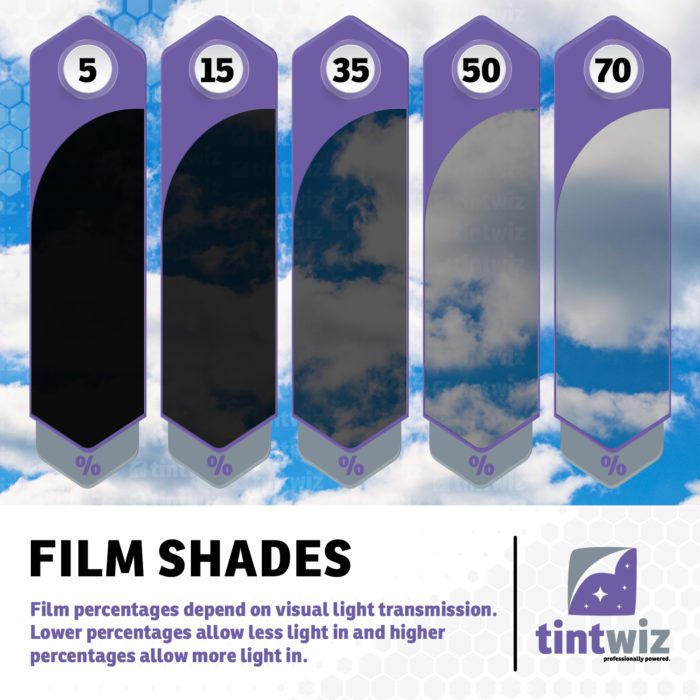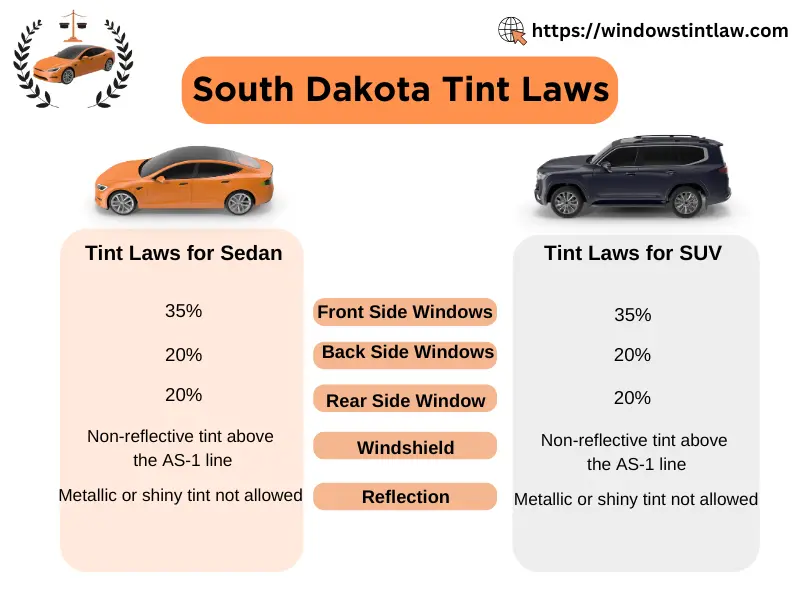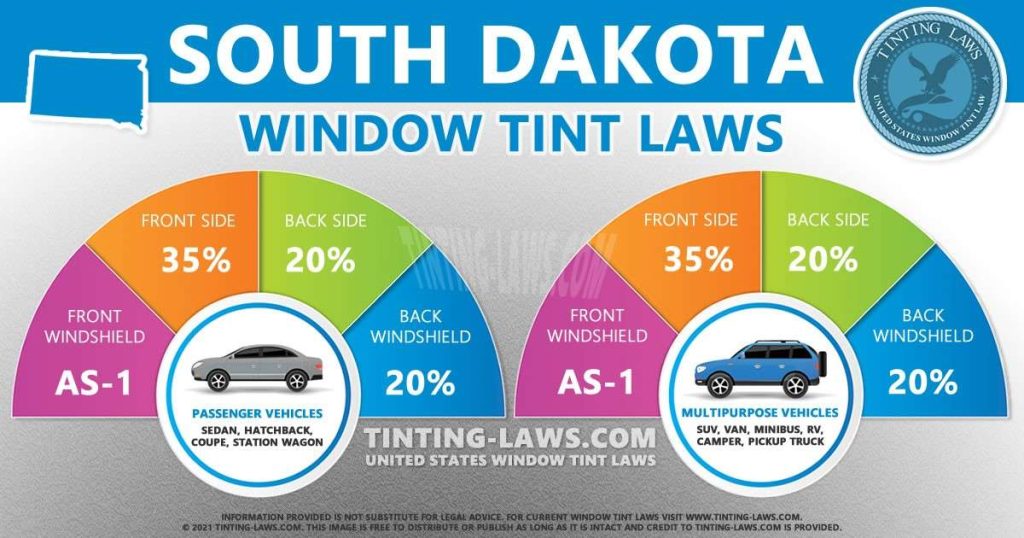Are you considering tinting your vehicle’s windows in South Dakota? Before you do, it’s crucial to understand the state’s tint laws to avoid any legal hiccups.
Window tinting can enhance your driving experience by reducing glare, improving privacy, and adding a sleek look to your car. However, not all tint levels are permitted, and using the wrong one can lead to fines or a failed inspection.
This article is your guide to the South Dakota tint law, ensuring you make informed decisions that keep you on the right side of the law. Dive in to learn how you can enjoy the benefits of window tinting while staying compliant.

Credit: tintwiz.com
Tint Law Basics
Understanding tint laws in South Dakota is crucial for vehicle owners. These laws ensure safety and compliance on the roads. They regulate how much light can pass through vehicle windows. This guide will help you grasp the basics of South Dakota’s tint laws.
What Is Window Tinting?
Window tinting involves applying a thin film to car windows. This film reduces the sunlight entering a vehicle. It provides privacy and protects from UV rays. It can also enhance the car’s appearance.
Why South Dakota Has Tint Laws
South Dakota enforces tint laws for safety reasons. These laws help ensure drivers have clear visibility. They also allow law enforcement to see inside vehicles. This visibility aids in quick assessments during stops.
Legal Tint Levels In South Dakota
South Dakota specifies legal tint levels for each window. The front windshield must allow more than 70% of light. Side and rear windows have more lenient rules. They can have darker tints, as long as they meet standards.
Penalties For Violating Tint Laws
Violating tint laws in South Dakota can lead to fines. Drivers may need to remove or adjust illegal tint. Repeated offenses could result in increased fines.
Exceptions To The Rule
Certain medical conditions may warrant exceptions. Drivers can apply for a medical exemption. This allows for a darker tint if medically necessary. Proper documentation must be provided to authorities.
Permissible Tint Levels
Understanding permissible tint levels is crucial for car owners in South Dakota. Tint laws regulate the darkness of window films. These laws ensure safety and visibility on the road. Each state has different rules about window tinting.
Front Side Windows
In South Dakota, front side windows must let in more light. The permissible tint level is 35% VLT. This means the window must allow 35% of light through. Darker tints are not legal.
Back Side Windows
Back side windows have more flexibility in tint levels. South Dakota allows any tint darkness for these windows. This gives car owners more freedom for rear windows.
Rear Window
The rear window also permits any tint darkness. This allows customization of rear window visibility. Ensure rear visibility is safe when choosing tint.
Windshield
Windshield tinting has strict regulations. Only non-reflective tint is allowed on the top 5 inches. This is to ensure clear visibility for drivers. The rest of the windshield must remain untinted.
Reflective Tint
Reflective tint is limited in South Dakota. Front and back side windows must not be overly reflective. Excessive reflection can impair visibility for drivers.
South Dakota offers exemptions for medical reasons. Individuals with certain conditions may apply for special tint permits. This helps those who need extra sun protection.
Window Tint Restrictions
South Dakota’s tint law permits front side windows to have up to 35% darkness. Rear windows can be tinted with any darkness level. Violating these rules may lead to fines, emphasizing the importance of understanding local regulations.
Understanding window tint restrictions in South Dakota is crucial for vehicle owners who want to strike the right balance between aesthetics, comfort, and legality. Tinting your car windows can enhance privacy and reduce glare, but it’s important to know the specific regulations to avoid fines. Let’s dive into the specific restrictions for different windows on your vehicle.Front Windows
Front window tinting must allow more than 35% of light to pass through. This ensures that drivers maintain a clear view of the road, enhancing safety for everyone. If you’re driving through the scenic landscapes of South Dakota, you’ll want to enjoy the view and stay compliant. A friend of mine once got pulled over because his front windows were too dark. It was a costly reminder of the importance of adhering to tint laws. You don’t want to miss out on a beautiful drive because you’re worried about getting a ticket.Rear Windows
The rear windows can have any level of tint. This flexibility allows you to maximize privacy and comfort for passengers. If you often travel with children or pets, a darker tint can offer them a cooler, more shaded environment. However, keep in mind that very dark tints may attract attention. It’s wise to strike a balance that suits your needs without drawing unnecessary scrutiny from law enforcement.Windshield Regulations
Windshield tinting is more restricted. Only the top 5 inches of the windshield can be tinted. This strip is usually referred to as an “eyebrow” and helps to reduce glare from the sun. Imagine driving towards the setting sun on a long stretch of highway. That upper strip of tint can be a lifesaver, preventing you from squinting and keeping your focus on the road. Are you considering tinting your vehicle’s windows? Ensure you understand these regulations to avoid penalties and enjoy a comfortable and stylish driving experience.Medical Exemptions
South Dakota’s tint laws aim to balance safety and personal needs. Medical exemptions allow certain individuals to use additional tinting for health reasons. These exemptions ensure people with medical conditions can drive comfortably and safely.
Who Qualifies For A Medical Exemption?
Individuals with specific medical conditions qualify for exemptions. Conditions include lupus, photosensitivity, and other disorders. A licensed physician must diagnose the condition. Documentation from the physician is required for the exemption process.
How To Apply For A Medical Exemption
Applying involves submitting official documents to the Department of Motor Vehicles. First, obtain a written statement from your doctor. The statement must detail the medical necessity for additional tint. Submit this document with your application form.
Restrictions And Limitations
Exemptions offer relief but come with restrictions. The law limits tint levels even for medical exemptions. These levels ensure safety for all road users. Exemption holders must adhere to these limits to avoid penalties.
Importance Of Compliance
Compliance with tint laws is crucial. It ensures road safety for everyone. Medical exemptions provide necessary relief but must be respected. Non-compliance can lead to fines and legal issues. Always verify your vehicle’s tint meets legal standards.
Penalties For Violations
South Dakota enforces penalties for violating tint laws. Fines start at $120 for improper window tinting. Repeat offenses can lead to higher fines and potential vehicle impoundment. Compliance is crucial to avoid these consequences.
Understanding the penalties for violating South Dakota’s tint law is crucial for anyone considering tinting their vehicle windows. It’s not just about following the rules; it’s about avoiding the consequences that come with breaking them. Let’s explore what happens if you’re caught with an illegal tint on your vehicle.Fines And Fees
If you’re pulled over with a tint that doesn’t comply with South Dakota law, expect to pay a fine. The fine can vary depending on the severity of the violation. Are you prepared to pay a hefty penalty for a decision that seemed minor at the time?Potential Court Appearance
In some cases, a violation could lead you to court. This isn’t just inconvenient; it can also be intimidating and stressful. Consider how much time and effort you’re willing to invest in defending a tint choice.Fix-it Tickets
You might receive a fix-it ticket, requiring you to remove or adjust the tint to meet legal standards. This means more than just removing the tint—it often involves additional costs for professional services. Are you ready to face this hassle just for a darker shade?Impact On Insurance
Insurance companies might not look favorably on violations. A tint violation could potentially affect your premiums. Is having a tint worth the risk of increased insurance costs?Repeat Offenders
If you continue to violate the tint laws, penalties can escalate. Repeat offenses might lead to higher fines or more severe legal consequences. How many chances are you willing to take before the consequences outweigh the benefits? Understanding these penalties highlights the importance of staying within the legal limits. Have you checked the tint on your vehicle lately?
Credit: windowstintlaw.com
Tips For Compliance
Complying with South Dakota’s tint laws is essential for drivers. Tint regulations ensure safety and visibility on the roads. Understanding these laws will help avoid fines and legal issues. Below are some tips for compliance with the South Dakota tint law.
Choosing Legal Tint
Selecting the right tint is crucial. South Dakota law specifies how dark the tint can be. Front side windows must allow over 35% of light in. Rear windows have more flexibility. Ensure your chosen tint meets these requirements. Look for labels indicating light transmission levels. Check these labels before purchasing.
Working With Professionals
Professional installation ensures compliance. Experts know the legal requirements. They use tools to measure light transmission accurately. Hire a reputable tinting service. Ask for certification. A certified installer guarantees lawful tinting. Proper installation prevents peeling and bubbling. This keeps the tint effective and legal. Professionals often provide warranties. A warranty gives peace of mind and ensures compliance.

Credit: www.tinting-laws.com
Frequently Asked Questions
What Is The Darkest Legal Tint In South Dakota?
South Dakota allows a maximum tint darkness of 35% for front side windows. Rear windows can have any darkness. Ensure compliance with local regulations for safety and legality.
In What State Is 20% Tint Legal?
20% tint is legal in several states, including California, Michigan, and New York. Laws vary by state, so check local regulations. Ensure compliance to avoid fines and safety issues. Always consult updated state guidelines for accurate information on window tinting laws.
How Dark Is 35% Tint?
35% tint allows 35% of light through, offering moderate privacy and glare reduction. It’s less dark than limo tint, providing a balanced look. Ideal for those seeking some privacy without significantly darkening windows. Perfect for maintaining visibility and comfort while driving.
Popular choice for everyday vehicles.
Is 5% Tint Legal In North Dakota?
5% tint is illegal on front side windows in North Dakota. Only back side windows and rear windows can have darker tints. Vehicles must comply with state regulations to avoid penalties. Always check local laws for updates.
Conclusion
Understanding South Dakota tint law keeps drivers safe and legal. The law helps ensure clear vision on the road. Keeping your tint within legal limits avoids fines. This protects everyone on the road. Stay informed about any updates to the law.
Local authorities often provide resources for drivers. Knowing the rules prevents unnecessary stress. Remember, compliance ensures safety and peace of mind. Make sure your vehicle meets the state’s tint standards. Respecting the law promotes a harmonious driving environment. Always prioritize safety over style with window tint choices.
